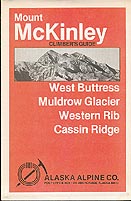
|
Climbing Alaska's Mt. McKinley has been described alternately as a long walk in the snow, or as one of the most difficult high mountain ascents in the world, depending 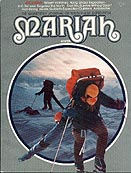 The Expedition
The ExpeditionThat Fell From The Sky on the route being climbed and conditions encountered along the way. Even in mid summer, conditions on North America's tallest mountain are arctic in character. During the two- to four-week ascent, most parties encounter temperatures ranging from + 70° to - 40° F. (+ 27° to - 40° C.). Winds in excess of 100 m.p.h. (160 k.p.h.) are not uncommon.  Individual storms sometimes last two weeks, making it imperative that climbers prepare for at least a month's climb on easier routes and as much as six weeks on difficult routes. Although nearly 3,000 climbers have stood on its 20,320-foot (6,194-meter) summit since the first ascent in 1913, none have treated the mountain casually. Over forty have died on its slopes. As on big mountains elsewhere, hidden crevasses have taken unnecessary lives. Climbers should always travel roped, no matter how easy the terrain appears. Expeditions planning to attempt Mt. McKinley must register at least two months in advance with the National Park Service and should complete all preparations before coming to Alaska, including arrangements for a radio and charter air transportation. Climbers should also plan on removing all their equipment and trash from the mountain.  West Buttress Westliche Stützmauer Le Contrefort de l'Ouest South Buttress Südliche Stützmauer Le Contrefort du Sud Muldrow Glacier Muldrow Gletscher Le Glacier Muldrow West Rib Westliche Rippe La Côte de l'Ouest Cassin Ridge Cassin Kamm La Crête Cassin Coming Soon Doug Scott & Dougal Haston's South Face Direct This map and the climbing descriptions can only serve as general guides to the five major routes on Mt. McKinley because of daily and seasonal conditions. On a big mountain, no guide or map can safely be substituted for good mountaineering judgement. Copyright © 2001 by Dennis Cowals. All rights reserved. Ice axe and rope logo copyright © 2001 by Dennis Cowals. Mountaineers edition copyright © 1981 by Dennis Cowals ISBN 0-89886-020-2. Original edition copyright © 1976 by The Alaska Alpine Company. |
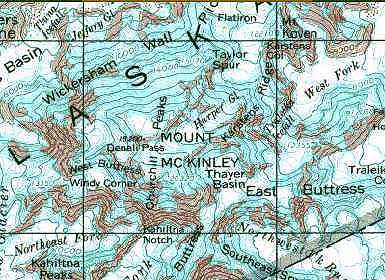
Mt. McKinley 1:250,000 scale - U.S. Geological Survey
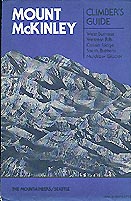
Denali National
Park & Preserve
Mountaineering
Guidelines,
Regulations
& Information
Mountaineering in
Denali National Park
& Preserve
National Weather Service
Alaska Region
Denali National Park
Weather Forecast
Wind Chill Calculator
North to Alaska?
These friends
are good folks
to contact.
We've shared
many climbs,
rescues and
adventures
over the years.
Westliche Stützmauer - Le Contrefort de l'Ouest
FIRST ASCENT: June 18 to July 1, 1951 by Dr. Bradford Washburn, William Hackett and James Gale. With air support provided by Dr. Terris Moore, then president of the University of Alaska, Washburn and three others pioneered the now familiar route up the Kahiltna Glacier and established a base camp at the 10,100-foot level below Kahiltna Pass. There, they waited for nine days until the other four members of the expedition arrived after making an overland trek from Wonder Lake to the Muddy River, up Birch Creek and finally across the Peters Glacier. United again as a single, strong party, the group continued to advance up the buttress along lines selected by Washburn from his aerial reconnaissance flights around the mountain until the climbers reached the South Summit. Within four days of the first ascent, all five of the other expedition members reached the summit. They were: Dr. Henry Buchtel, Barry Bishop, John Ambler, Jerry More and T. Melvin Griffiths.
POINT OF DEPARTURE: Southeast Fork, Kahiltna Glacier
ALTITUDE GAIN: 13,320 feet (4,060 meters)
ROUND TRIP DISTANCE: 32 miles (52 kilometers), not
including relays which can double the overland distance TIME: 15 to 30 days
CRUX: Headwall between 15,000 and 16,000 feet
(4,572 and 4,877 meters)
SPECIAL EQUIPMENT: 1,200 feet (400 meters) of fixed line
and six snow pickets to protect climbers moving up and
down the headwall
ROUTE: From the landing area outside the park boundary at the 7,000-foot (2,194-meter) level of the Southeast Fork of the Kahiltna Glacier, proceed down glacier, west, to the junction with the main stream of the Kahiltna Glacier. Turn right, north, and proceed approximately 8 miles (13 kilometers) toward Kahiltna Pass, a prominent notch in the northern skyline.
After gaining a small plateau east of the pass, move to the left of the prominent icefall and follow the obvious ridgeline toward the granite base of the West Buttress.
Still moving up the snowfield -- well clear of the avalanche chutes on the buttress -- turn left, east, upon reaching Windy Corner at 13,400 feet (4,084 meters). From this point the route follows an easterly course between the rock buttress on the left and a large icefall on the right until it reaches a nameless basin at 14,200 feet (4,328 meters).
In the basin, the route turns left and follows a northerly course directly up a prominent couloir leading to the top of the West Buttress at 16,000 feet (4,877 meters). This is the steepest section of the route and the one climbers often refer to as the Headwall. It is here, between 15,000 and 16,000 feet (4,573 and 4,877 meters) that parties sometimes install a fixed line to safeguard climbers relaying loads to the top of the buttress. Teams climbing the route early in the season may use two 600-foot spools or two 200-meter reels of rope to fix the route up the couloir.
At the crest of the ridge, turn right, east, and thread a path through the granite blocks on the ridgeline for 1.5 miles (2.4 kilometers) to the complex of ice caves known as the Iglooplex at 17,320 feet (5,251 meters). Continue up the ridge and traverse a long snow slope to the left to reach Denali Pass at 18,200 feet (5,547 meters).
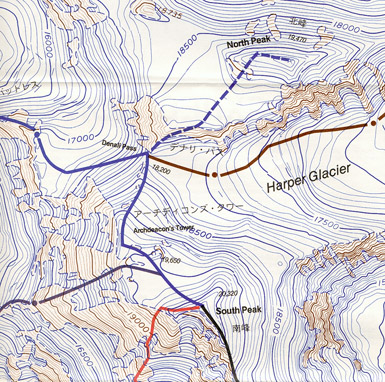
Mt. McKinley Summit 1:25,000 - adapted from U.S.G.S.
West Buttress Muldrow Glacier
West Rib Cassin Ridge South Buttress
The true summit lies about the same distance from Denali Pass as the lesser, northern peak, but in a southeasterly direction. Climb the ridge leading up and south from the pass for a little more than one-half mile (1 kilometer), then turn left, east, toward the Archdeacon's Tower after passing a small, rocky ridge at 19,400 feet (5,193 meters). Continue east between the Archdeacon's Tower on the north and a rock knob to the south. Descend into a broad basin and cross it. Climb the basin's eastern slope to the final ridge leading to the South Summit at 20,320 feet (6,194 meters).
CAMPS: Seven or eight camps are normally made by parties ascending the West Buttress. Climbers planning to traverse the mountain and descend via the Muldrow Glacier Route routinely place another camp on the east side of Denali Pass before attempting either summit.
Camp 1 7,000 ft. 2,134 m.
Camp 2 7,200 ft. 2,195 m.
Camp 3 7,800 ft. 2,377 m.
Camp 4 9,000 ft. 2,743 m.
Camp 5 11,000 ft. 3,352 m.
Camp 6 12,700 ft. 3,871 m.
Camp 7 14,200 ft. 4,328 m.
Camp 8 16,400 ft. 4,999 m.
Camp 9 17,320 ft. 5,251 m.
| South Buttress |
West Buttress | West Rib |
